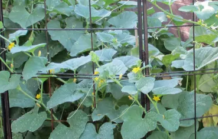[youtube https://www.youtube.com/watch?v=_qM2fv6v3-I]
Healthy soil is the foundation of organic farming.
NRCS can help farmers and ranchers with a number of conservation practices that build healthy soil. Diverse crop rotations, cover crops, nutrient management and conservation tillage are examples of practices that feed the soil, reduce erosion, improve soil structure, and enhance nutrient cycling and water retention.

Emma Chow
NRCS Soil Conservationist, CA
“Beginning with a soil analysis helps set a benchmark. From there we check what’s in the irrigation water, then look at the soil amendments a farm applies. Organic growers… often include compost, cover crops, fish emulsion, and lime… Our goal is to minimize the over-application of these nutrients.”
Four Soil Health Principles
1. Use plant diversity to increase diversity in the soil.
2. Manage soils more by disturbing them less.
3. Keep plants growing throughout the year to feed the soil.
4. Keep the soil covered as much as possible.

Crop Rotation
By rotating crops across their fields from season to season, organic farmers add biodiversity and increase resilience in their operations while increasing their soil’s organic matter
 “The NRCS is kind of a best-kept secret. They have a really good cover program that encouraged us to diversify. We were planting two species and now we’re planting five.” Richard DeWilde, Harmony Valley Farm, WI
“The NRCS is kind of a best-kept secret. They have a really good cover program that encouraged us to diversify. We were planting two species and now we’re planting five.” Richard DeWilde, Harmony Valley Farm, WI
Cover Crops
Instead of leaving land fallow after each harvest, cover crops act as a green manure, providing an additional source of nutrients that build soil organic matter and reduce the need to bring in additional inputs from off-farm sources.
Nutrient Management
If crops need additional nutrients, NRCS can help producers develop; a nutrient management plan that incorporates organic plant, animal, and natural mineral-based fertilizers, most of which release nutrients gradually through the action of soil organisms.
Conservation Tillage and Organic No-Till
Organic no-till systems, such as the roller-crimper, have also helped organic producers reduce the intensity of soil disturbance in annual crop rotations.

“If you don’t cover crop your soil, there’s nothing holding it together.” Simon Ziegler, Sun Sprout Farm, Chester, NY
By using NRCS soil principles and systems, farmers can sequester more carbon, increase water infiltration, and improve wildlife and pollinator habitat – all while harvesting better profits and often better yields.
“NRCS is a great resource for understanding some baseline things, like soil types and characteristics of a particular growing environment right up through supporting cover cropping, high tunnels and a whole range of technical assistance and financial support.”

JACK HEDIN
Featherstone Farms, MN




